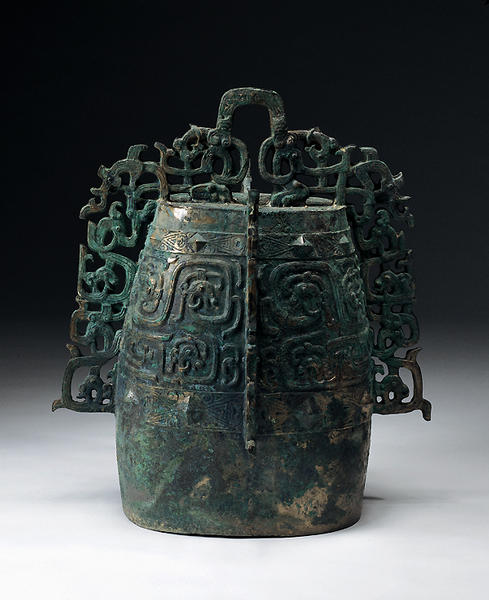鎛
- 中国
- 中国・東周時代
- 7cB.C.
- 青銅製
- H-67.3
この壮麗な鐘は鐃(図録NO.79)と明らかに異なり、一般にハクと呼ばれる第二の主要な鐘の種類に属する。青銅器時代の中国で制作され、用いられた。この作品は、両端が尖った楕円ではなく円みある楕円の横断面と、口は、窪んでおらず平らである。これは鐃のように口を上にして立てるのではなく、口を下にして垂直につり下げられたのである。ハクも「舌」がなく、口の真上の中央点を槌で打って音を出す。大型のハクは、大型の鐃と同様、華南に特有のものである。
これは殷代において鐃とは別の発展を経てきた種類の鐘であり、下端は平坦で吊り下げて使った。はくを四分する接合面の大きな突起に施された流麗な蟠ち文が顕著であるが、先立つ殷の扱い方に比べ透かし彫りを駆使するなど周代に特有の意匠表現が見られる。これは鋳造時の型枠の結合部に適応された装飾であり、西周末から東周初にかけて細い線状の体躯を持ちしばしばからみあった獣や龍、蟠ち(ばんち:角の無い竜)、蟠き(蛇)の意匠が発達した。はく身の上下に変形蝉文と菱形の枚で構成される帯があり、その間に舌を吐く双頭の蟠ち文が二段になって施されている。舞部にもこの蟠ち文が施されているが、これら蟠ちの鼻先は丸く立体的に表現され、眼も突出している。このはくは陝西省宝鶏県太公廟村から発掘された東周春秋時代の三個組の秦公はくに大変近い様式を持っており、同様に春秋時期に作られたものであると想像される。
Catalogue Entry
Distinctly different from the nao (cat. no. 79), this magnificent bell represents the second major category of bells, commonly called bo, made and used in Bronze Age China. It has a rounded oval (rather than pointed oval) cross-section and a flat (rather than concave) mouth. It was hung vertically with mouth down--not stood mouth up as was the nao. The bo also does not have a clapper and was sounded by striking a central spot just above the mouth with a mallet. Although they may have originated from small clappered harness bells found in early Shang sites in the north that yielded plaques like catalogue number 77, large bo bells, like large nao, are peculiar to south China.1
Like the nao, the earliest bo bells also occur singly, never in sets. They began to appear in sets during the tenth or ninth century B.C. in north Chinese sites, together with chimes of obliquely hanging yongzhong, descendants of the nao.2 But the number of bo bells in a chime remained small, usually three to a set.3 The monumentality and rarity of the early bo bells suggest they might have had a special status and function within the percussion assemblage.4 The fact that the gift bell from the King of Chu for the Zeng Hou Yi's funeral in 433 B.C. was a single large bo supports an unusual status of the type.5 Furthermore, because its different cross-section and flat mouth do not allow the bo to produce two tones (as does the yongzhong), the bo bell may have served to accent the tempo or underlying rhythms for the melodies produced by the musical two-toned bells. However, by the late sixth century B.C., larger sets began to appear with bo bells having a pointed oval cross-section, many of them also capable of producing two tones, just like the chimes of yongzhong that often accompany them.
The present bo came from the transitional period of the bell's history, as it remains a one-toned instrument.6 It displays a distinctive profile that swells from the top to just below the mid-point, from which it tapers slightly toward the mouth. Raised pyramidal bosses accent the top and bottom borders of its two faces, while magnificent openwork flanges, composed of interlacing dragons, divide its body into four quadrants. These features are all associated with bo from the preceding tenth and ninth centuries B.C.7 But its primary decoration--four dragons in rounded relief, their bodies linked in bold S-shaped bands, each occupying one quarter of a quadrant--is a distinct departure from the single large taotie rendered in concave bands that filled the same spaces on the earlier bells. Furthermore, the excavation of a set of three nearly identical bo bells, datable to the early seventh century B.C., from Taigongmiao, Baoji Xian, Shaanxi province,8 suggests that this bo might have been part of a similar set of three, predecessors to the larger sets that appeared in subsequent centuries.
Bo bells with elaborately interlaced, openwork flanges aligned along four quadrants, like the Shumei example, form a rare and select group among known bells of this kind. Descended from the earliest versions, dating from the late Shang period, with large hooked flanges,9 and closely contemporaneous with a distinctive southern group with tiger flanges from the late Western Zhou period,10 the complex flanges on the Shumei bell are found only on two other known examples: a single bell, the Ke bo, in the collection of the Tianjin Museum11 and the set of three from Taigongmiao already mentioned, which are closely associated with important personalities in the heartland of Zhou bronze production. It is likely that the Shumei bell belonged to a similar metropolitan or social milieu.
The flanges along four quadrants on these bo bells appear to have required different mold assembly methods than those commonly used for producing other bells.12 Casting seams visible along the narrow edges of the four flanges of the Shumei bo suggest that four mold sections were used to form its main body.13 An additional seam, extending horizontally out at the flat top of the bell to the openwork flanges on either side, suggest that two additional mold sections--forming the bell's top, the openwork suspension device, and the top sections of the flanking flanges--were used.
JFS
1. For a detailed discussion of the development of the bo bell see Falkenhausen 1993, pp. 168-74; Zhu and L 1994, pp. 13-21, 60-69.
2. See Falkenhausen 1993, pp. 153-57.
3. The only Western Zhou set of three bo excavated to date is that from Yangjiacun, Mei Xian, Shaanxi province (Wenbo 1987.2, pls. 3.3-4, p. 22, fig. 3.
4. Zhu and L 1994, pp. 13-15.
5. So 1995, fig. 79.1.
6. The bell's single tone approximates D# (information courtesy of the bell's previous owner).
7. For these early examples see above n.2; Rawson 1990, figs. 129.6, 129.7.
8. Wenwu 1978.11, pl. 2.
9. See Bagley 1987, no. 104.
10. See Rawson 1990, no. 129.
11. Wenwu 1972.6, p. 14, pl. 6.
12. For descriptions of standard mold constructions see Rawson 1990, nos. 123-27; So 1995, pp. 75-79.
13. For similar mold assembly techniques see Rawson 1990, no. 129.
